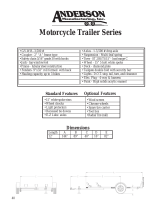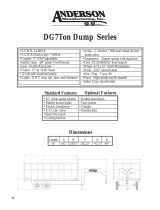
BEFORE YOU TRAILER
SAFETY CHAINS Always attach safety chains between your
vehicle and your trailer and cross them under the tongue of
the trailer so that the tongue will be less likely to drop if the
trailer should separate from the hitch. Leave enough slack
in the chains so you can corner without the chains impeding
the movement of the trailer. Do not allow safety chains to
drag on the ground.
LOADING YOUR TRAILER Load your trailer to attain a 10%–15%
tongue weight. A good rule of thumb is to distribute 60% of the
load over the front half of the trailer and evenly from side to
side. Loads sitting either too far forward or too far back in the
trailer can create unstable trailering conditions —such as trailer
sway — at highway speeds and during heavy braking. Once the
trailer has been loaded and the weight is distributed properly,
all cargo should be secured to prevent the load from shifting.
SAFETY CHECKLIST Before starting out on a trip, double-
check the hitch and platform, the hitch nuts and bolts, mirror
adjustments, safety chains, and vehicle and trailer lights.
Make sure that a sway-control device is installed, if required,
and that the device is working properly (see charts on pages
09–14). Check tire pressure on both the tow vehicle and the
trailer. If your trailer has electric brakes, test them by
manually engaging the brake controller while the vehicle is
moving slowly. Check to see that the breakaway switch, if
available, is connected and functioning properly. Finally,
make certain that all loads are secure.
ON THE ROAD
ACCELERATING/BRAKING Avoid overworking your engine when
trailering by applying gradual pressure on the accelerator. Allow
your vehicle to safely reach a comfortable driving speed. Give
yourself extra time and room when merging onto highways.
Braking when pulling a trailer requires extra distance. Allow
ample room to come to a safe stop. A good measure for
06 THINGS YOU SHOULD KNOW BEFORE YOU START TRAILERING
determining a safe following distance is to allow one vehicle and
trailer length between you and the vehicle ahead of you for
every 10 mph of speed. When braking, use firm, steady pressure
on the brake pedal.
CONTROLLING TRAILER SWAY Sway refers to instability of the
trailer relative to the tow vehicle, and often results from
improper weight distribution, excessive speed or overloading.
Other factors that can cause sway are crosswinds, poor vehicle
maintenance and road conditions. Trying to steer out of sway
will likely make it worse. Speed is a major contributor to trailer
sway, so you need to slow the vehicle — braking, however, could
lead to a jackknife or other loss of control.
TO CONTROL SWAY
• Hold the steering wheel as steady as possible
• Release the accelerator but do not touch the brake pedal
• Activate electric trailer brakes (if equipped) by hand, until the
sway condition stops
• Use the vehicle brakes to come to a complete stop
You should then pull your vehicle to the side of the road and
attempt to determine the cause of the instability. Check the
cargo load for shifting and improper weight distribution.
Check tire pressure on the tow vehicle and trailer and the
condition of the suspension and shocks. If the sway was
caused by strong winds, wait for conditions to improve before
continuing your trip.
Finally, some trailers can be equipped with anti-sway devices.
Contact the manufacturer of your trailer for availability.
CORNERING The turning radius of a trailer is typically much
smaller than that of your vehicle; therefore, a trailer may hit soft
shoulders, curbs, trees or other objects when making tight
turns. Taking turns sharply can also cause the trailer to strike
against and damage the tow vehicle. When approaching a sharp
corner, brake sooner than normal to reduce vehicle speed
before entering the turn. Drive the vehicle slightly past the
normal turning point then firmly turn the steering wheel. By
cornering at a wider angle, both the vehicle and trailer should
safely clear the inside of the turn.
PASSING When passing, allow additional time and distance to
safely pass the other vehicle. Signal your intention to pass well
in advance and, when reentering the lane after passing, make
certain your trailer is clear of the vehicle you have passed.
Never pass on hills or around curves.
BACKING UP To back up a trailer, place one hand at the six
o’clock position on the steering wheel. To move the trailer to the
left, move your hand to the left. To move the trailer to the right,
move your hand to the right. Back up slowly and move the
steering wheel in small increments to help maintain control.
To assist in backing up, it is helpful to have someone outside
the vehicle to guide you. Make certain you can see your spotter
at all times.
DRIVING ON GRADES Before going down a steep grade, reduce
your speed and shift the transmission into a lower gear. This
provides “engine braking” and reduces the need to brake for
long periods. Chevrolet crossover, SUV and pickup models
equipped with a 6-speed automatic transmission, as well as
pickups equipped with the available 8-speed automatic have a
grade braking feature in the transmission which can do this for
you. See your dealer or Owner’s Manual for additional
information. When driving up a steep incline, shift to a lower
gear for more torque to maintain speed and avoid lugging.
Lugging occurs when the vehicle’s engine stutters because it
needs to be in a lower gear. Crest the hill no faster than the
speed at which you want to descend and in the gear you
expect will require little braking. Pay attention to your
temperature gauges for any signs of overheating.

















